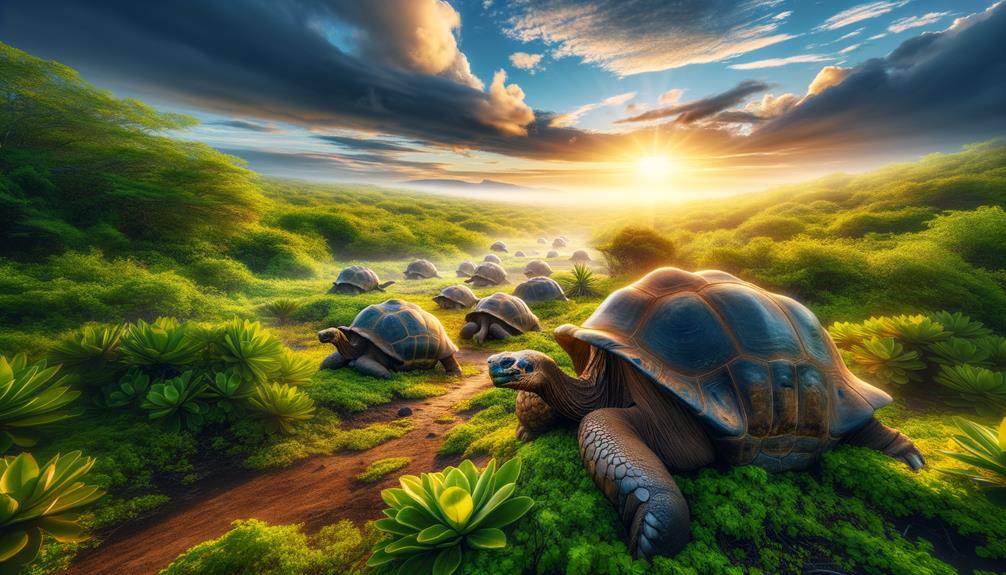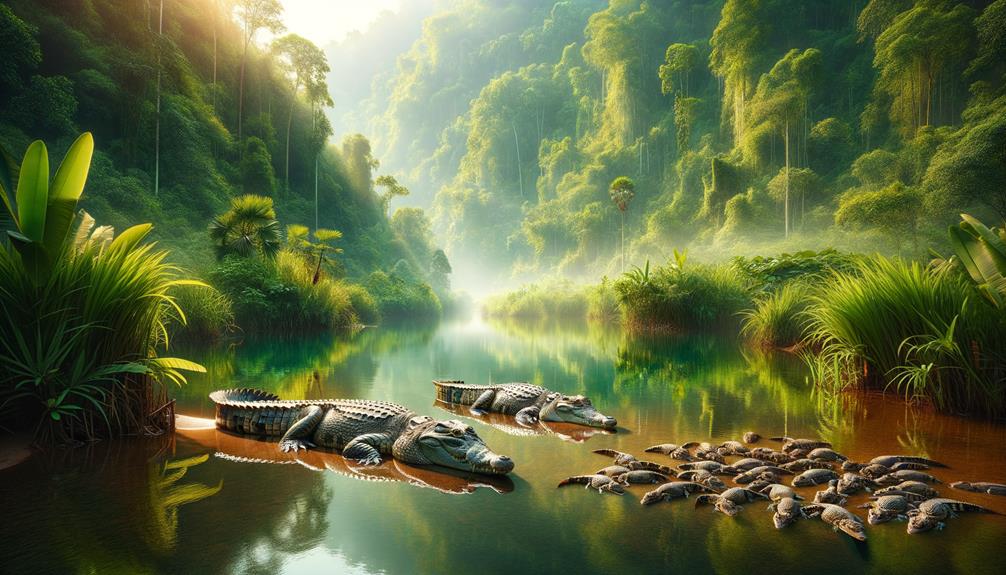I've witnessed the devastating impact of poaching on the Ploughshare Tortoise, with fewer than 600 adults remaining in the wild. To combat this, we're utilizing innovative tools like radio telemetry and drones to track and protect these incredible creatures. The local communities in Madagascar are vital partners in our efforts, helping us patrol and monitor these precious tortoises. We're also working globally to share intelligence and boost law enforcement efforts. To disrupt the illegal trade, we're providing alternative livelihoods and educating locals about the importance of preserving their unique natural heritage. Every measure we take counts in this critical mission.
Key Takeaways
To effectively track tortoise movements and monitor poachers, we can use radio telemetry and drones for real-time surveillance.
Local communities can play a crucial role in anti-poaching patrols, and providing alternative livelihoods can reduce their dependence on illegal activities.
Hidden cameras and thermal imaging technology can be used for effective surveillance and early detection of poachers.
International cooperation and law enforcement efforts can disrupt illegal wildlife trade and share intelligence globally.
Educating local communities about the ecological importance of the Ploughshare Tortoise and incentivizing their participation in conservation efforts can make a significant difference.
Threat of Poaching
Poaching has pushed the Ploughshare Tortoise to the edge of extinction, with fewer than 600 adults remaining in the wild. The illegal wildlife trade drives this critical threat, fueled by the high market value of these tortoises, which can sell for tens of thousands of dollars. This lucrative market has led to a surge in poaching, bringing the species closer to extinction.
Baly Bay National Park in northwest Madagascar, the Ploughshare Tortoise's only remaining habitat, has become a hotspot for poachers. The park's rugged terrain and limited access make it difficult for law enforcement to patrol effectively, allowing poachers to operate with relative ease.
The illegal wildlife trade involves more than just removing tortoises from their natural habitat; it's also linked to corruption, violence, and habitat destruction. Law enforcement faces significant challenges in combating this illicit activity, including the risk of violence and imprisonment.
The situation is urgent, and immediate action is needed to prevent the Ploughshare Tortoise from disappearing forever.
Conservation Strategies
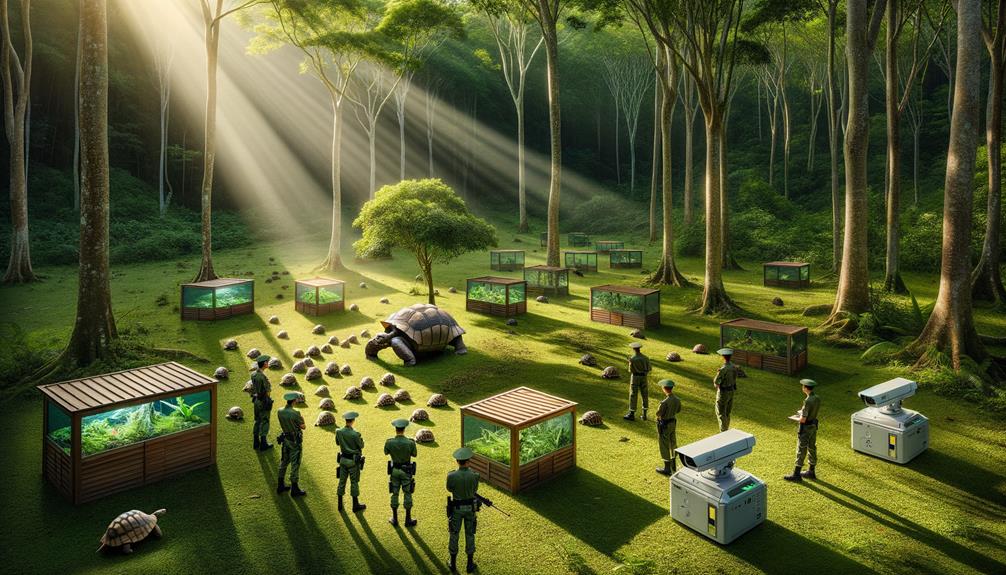
To save the Ploughshare Tortoise from extinction, a multi-faceted conservation strategy is necessary. This approach must involve local communities in Madagascar, educating them about the dangers of poaching and enlisting their help in conservation efforts. By doing so, we can reduce illegal poaching. Local communities can also participate in patrols, helping to monitor and protect the tortoises.
On-the-ground rangers and biologists need resources like boats for quicker response times and radio telemetry to track and monitor the Ploughshare Tortoise population. Defacing tortoises to make them less attractive to poachers has proven effective.
The Durrell Wildlife Conservation Trust's initiatives to strengthen disincentives for illegal behavior and provide monetary incentives for community intelligence are vital. These efforts not only deter poaching but also offer local communities alternative livelihood options.
Securing breeding facilities and enforcing anti-poaching and anti-trafficking laws are ongoing challenges. We must combine the efforts of various organizations and the government to protect the habitat and secure a future for the Ploughshare Tortoise. This collaborative approach can make a difference.
Role of Technology

Cutting-edge technology is playing a vital role in safeguarding the endangered Ploughshare Tortoise from poachers. With radio telemetry, we're able to track these remarkable creatures, logging their movements and environmental data. This information is crucial for understanding their behavior and habitat needs, enabling us to develop effective conservation strategies.
Hidden cameras are instrumental in monitoring their habitat. By capturing footage of the area, these cameras help us detect and deter poachers. The mere presence of these surveillance tools can be a powerful deterrent.
Thermal imaging cameras and drones are revolutionizing our efforts. They allow us to scan vast, remote areas efficiently, spotting poachers even at night. This real-time aerial surveillance provides us with a bird's-eye view of potential threats.
On the ground, our patrol teams use smartphone-based software to record and analyze data on poaching incidents and trends. This data-driven approach guides our decisions, ensuring our actions are informed and effective.
Each piece of technology, from radio telemetry to drones, is a vital component of our strategy to protect the Ploughshare Tortoise. By harnessing these tools, we're giving these endangered tortoises a fighting chance.
Community Involvement
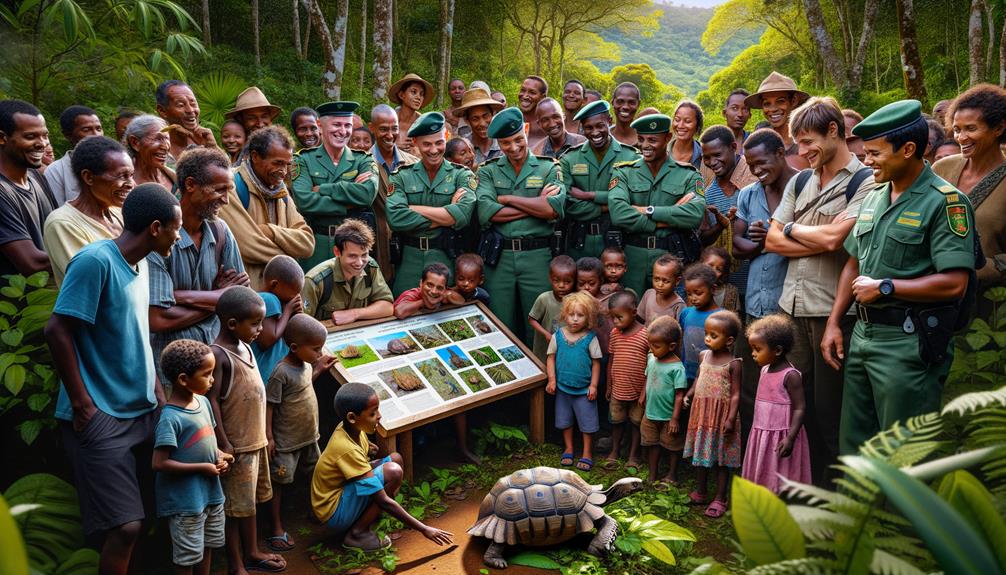
Involving local communities in Madagascar is vital to protecting the Ploughshare Tortoise from poaching threats. By partnering with local communities to provide intelligence and support to anti-poaching patrols in Baly Bay National Park, we tap into their in-depth knowledge of the land and its challenges. Community-based conservation projects offer financial incentives and alternative livelihoods, discouraging illegal poaching and fostering a sense of responsibility for the tortoise's survival.
Our community outreach programs aim to educate local communities about the ecological importance and endangered status of the ploughshare tortoise. Through education, we instill a sense of pride and ownership among local stakeholders, making them active participants in conservation efforts. By strengthening community participation, we ensure that conservation is a collaborative effort rather than an external imposition.
Local communities are crucial allies in combating the illegal trade in ploughshare tortoises. By involving them in conservation efforts, we transform potential poachers into protectors, guaranteeing long-term success. By fostering community involvement, we not only safeguard the ploughshare tortoise but also enhance the resilience and well-being of the communities themselves. This community-based approach is key to securing a future where both tortoises and people thrive.
Global Cooperation
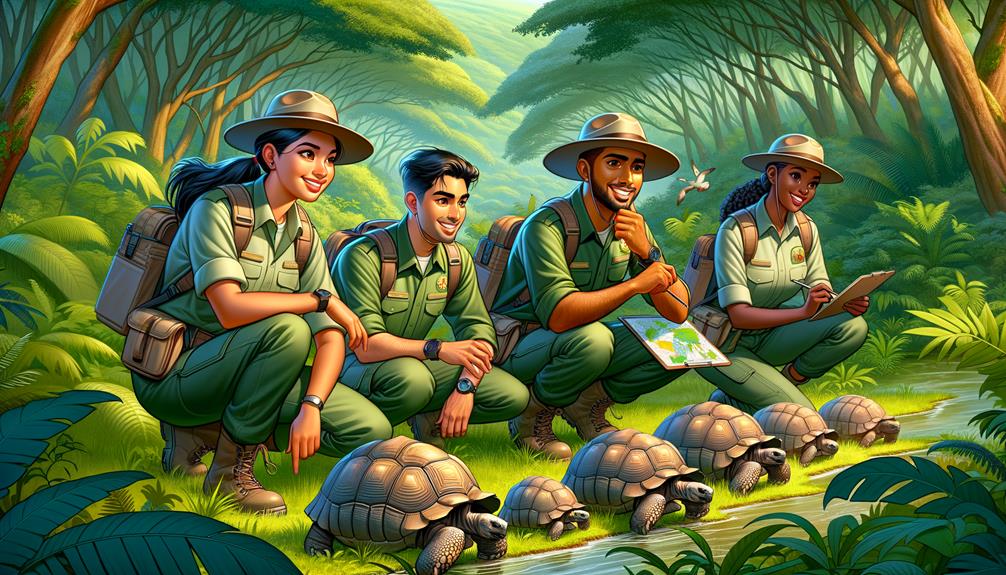
Global cooperation is vital to dismantle the complex networks behind the illegal trade of ploughshare tortoises. By working together across borders, we can strengthen law enforcement, share intelligence, and coordinate anti-poaching efforts more effectively. The Turtle Conservancy and Durrell Wildlife Conservation Trust have teamed up with Madagascar National Parks, TRAFFIC Southeast Asia, and other stakeholders to protect this critically endangered species.
International partnerships are crucial to wildlife conservation. Madagascar's commitments at CITES conferences have highlighted the urgency of stopping the poaching and trafficking of ploughshare tortoises. These agreements have sparked global cooperation, leading to concrete actions on the ground. For example, funding from the UK government's Illegal Wildlife Trade Challenge Fund and Jersey Overseas Aid has enabled impactful conservation projects that engage local communities and boost law enforcement.
Sharing information and resources among conservation organizations, government agencies, and law enforcement across range, transit, and destination countries is key. This unified approach disrupts illegal trade supply chains and provides a complete strategy for poaching prevention. By fostering these international partnerships, we can give the ploughshare tortoise, a symbol of biodiversity and resilience, a fighting chance for survival.
Frequently Asked Questions
Why Are Ploughshare Tortoises Poached?
In a desperate struggle for survival, ploughshare tortoises are being hunted for their striking golden shells, which can fetch high prices from collectors. The lack of effective law enforcement and widespread poverty in their habitats only make matters worse, pushing these incredible creatures closer to extinction.
What Are the Threats to the Ploughshare Tortoise?
The ploughshare tortoise is facing numerous threats, including the destruction of its habitat, illegal wildlife trade, and the presence of invasive species. These human-induced harms put the tortoise's very existence at risk. It's crucial we take action to protect these remarkable creatures and ensure they can thrive in their natural habitats.
What Are the Predators of the Ploughshare Tortoise?
Imagine a world where ploughshare tortoises thrive, free from threats like humans, carnivorous mammals, birds of prey, large snakes, mongoose, and feral cats. Unfortunately, human actions amplify these dangers, pushing them closer to extinction.
How Much Is a Ploughshare Tortoise Worth?
A ploughshare tortoise can fetch up to $40,000 on the black market, mainly due to its striking golden and black shell that makes it highly sought after. Unfortunately, this has led to illegal trade and pushed these beautiful creatures to the brink of extinction.


